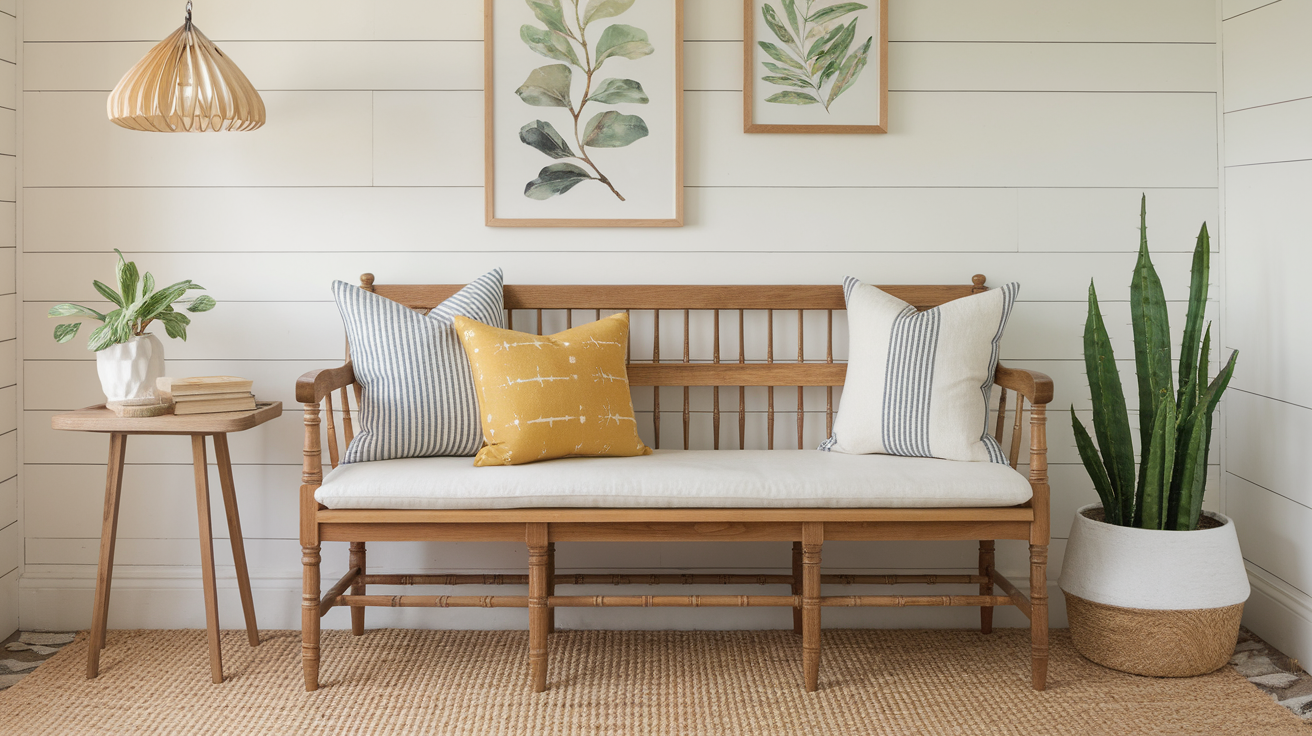Are you sitting on a hard, uncomfortable bench right now?
Most people struggle with finding bench cushions that fit perfectly and match their style. The good news is that you can make your own custom bench cushion with basic materials and simple steps.
Creating a DIY bench cushion gives you control over the size, fabric, and comfort level – all while saving money compared to store-bought options. This guide walks you through the entire process from selecting the right fabric to adding final touches on your finished cushion.
We’ll even share no-sew options for those who prefer alternatives to stitching. Follow along to change your rigid bench into a cozy, inviting seat that fits your exact needs.
What Is the Best Fabric for a DIY Bench Cushion?
When choosing the best fabric for a DIY bench cushion, consider durability, comfort, and style. The top choices include:
-
Canvas: A durable, thick fabric that’s easy to clean and ideal for both indoor and outdoor use. Its sturdy texture makes it great for high-traffic areas.
-
Upholstery Fabric: Known for its strength and variety of patterns and textures, upholstery fabric adds a luxurious touch to your bench cushion and withstands regular use.
-
Linen: If you want a lighter, breathable option, linen offers a natural, crisp look. However, it may require more upkeep as it wrinkles easily.
-
Velvet: Perfect for a plush, high-end feel, velvet is soft and elegant, though it may not be as durable as canvas or upholstery fabric.
-
Outdoor Fabrics: For benches exposed to the elements, outdoor fabrics like Sunbrella are water-resistant, fade-proof, and perfect for outdoor cushions.
Ultimately, the best fabric depends on the look you want and the cushion’s intended use.
Step-by-Step Guide to Crafting Your Bench Cushion
Materials Needed for DIY Bench Cushion
| Item | Purpose | Notes |
|---|---|---|
| Fabric | Cushion cover | Choose durable canvas or upholstery fabric |
| Foam cushioning | Inner filling | 2 inches thick recommended for comfort |
| Measuring tape | Taking accurate measurements | Metal tape preferred for precision |
| Scissors | Cutting fabric | Fabric scissors work best |
| Sewing machine | Stitching pieces together | Basic straight stitch is sufficient |
| Thread | Securing fabric pieces | Match color to your fabric |
| Velcro strips | Closure mechanism | Self-adhesive type is easier for beginners |
| Iron | Preparing fabric for sewing | Helps create crisp edges and folds |
| Marking tools | Indicating cut lines | Fabric chalk or washable pencil |
| Straight pins | Holding fabric in place | Optional but helpful |
| Seam ripper | Opening corners for top/bottom | Essential for proper assembly |
| Liquid stitch | Optional fabric adhesive | Can help with tricky areas |
| Paper | Creating patterns/diagrams | Helps with planning and cutting |
| Ruler | Ensuring straight cuts | Helpful for precise measurements |
Step 1: Measure Your Bench
Take time to measure the length and width of your bench surface carefully. Add 1 inch to each measurement to allow for seam allowance. This extra inch gives you room for a half-inch seam on each side. Write down these numbers so you don’t forget them when shopping for materials.
Step 2: Plan Your Fabric Needs
Draw a simple diagram showing all pieces needed for your cushion. You need a top and bottom piece of the same size. You also need front and back pieces based on the length and height of your cushion.
The side pieces are based on the width and height. Most fabric rolls are 58 inches wide, so plan how to fit all pieces when the fabric is folded in half.
Step 3: Select and Cut Your Fabric
Choose a strong, durable fabric that can withstand regular use. Lay out your fabric and mark all measurements with chalk or pencil. Cut each piece with care, checking that corners are square and straight.
Double-check all measurements before making any cuts to avoid wasting fabric.
Step 4: Prepare the Closing Mechanism
Iron the section of fabric where you’ll place the Velcro strips. This creates a smooth surface for better adhesion. Attach both the hook and loop sides of the Velcro to their proper places on the fabric.
Sew around the edges of the Velcro to secure it firmly. Make sure the strips will align when the cushion cover is closed.
Step 5: Sew the Sides Together
Place the right sides of your fabric pieces together so the pattern or nice side is facing inward. Pin the edges to hold everything in place while you sew.
Use a half-inch seam allowance as you sew all four sides together to form a tube shape. Do not backstitch at the corners as this will be handled later.
Step 6: Prepare for Attaching Top and Bottom
Use a seam ripper to open about half an inch of stitching at each corner. This creates the space needed to properly attach the top and bottom pieces. This step ensures your corners will look neat and professional when the cushion is finished.
Step 7: Attach Top and Bottom Pieces
Pin the top piece to the side tube with right sides together. Sew around the entire perimeter using your half-inch seam allowance. At each corner, add a backstitch for extra strength and durability.
Repeat this process with the bottom piece, but leave the section with the Velcro open for turning and inserting the foam.
Step 8: Turn and Insert Cushion
Turn the cover right side out through the opening you left at the Velcro section. Push out all corners so they look sharp and defined. Insert your foam cushion through the opening, adjusting it until it sits evenly inside the cover. Close the Velcro to secure the cushion inside.
Step 9: Final Touches
Clean your bench surface before placing your new cushions down. This removes any dust or debris that might have collected during your project. Set your cushion on the bench and make any small adjustments needed for a perfect fit. Smooth out any wrinkles in the fabric for a finished look.
Video Tutorial
Refer to the video by Milani & Wayne for a complete visual tutorial on Diy Bench Cushion.
How to Make Bench Seating Comfortable
Creating a comfortable bench seating area is all about adding the right elements for support and coziness. Here are a few tips:
-
Add Cushions: Invest in high-quality cushions or make your own DIY bench cushion. Look for thick, supportive foam to ensure comfort for extended sitting.
-
Use Soft Fabrics: Choose fabrics like velvet, cotton, or linen for cushion covers that are soft to the touch and breathable.
-
Incorporate Backrests: If possible, add a padded backrest for extra support. A cushioned backrest can significantly enhance the comfort level, especially for longer periods of sitting.
-
Layer with Throws: Add a cozy blanket or throw pillows for added comfort and a pop of style.
-
Consider Seating Height: Ensure your bench seat is at the right height for ease of sitting. Too high or too low can lead to discomfort, so aim for the right balance.
By adding these simple touches, you can easily turn any bench into a comfortable and inviting seating area.
Alternate Ideas for Cushions Without Sewing
If sewing isn’t your thing, no worries! There are several creative ways to make a cushion without picking up a needle. Here are some simple alternatives:
1. Fabric Glue
Use fabric glue to bond fabric pieces together, creating a seamless, no-sew cushion cover. Simply cut your fabric, apply the glue to the edges, and press them together. Allow it to dry for a strong, lasting bond.
2. Staple Gun
For a sturdy cushion, use a staple gun to attach fabric around the foam. This method is quick and provides a neat finish, especially when the fabric is tightly pulled and stapled around the edges.
3. No-Sew Pillowcase Style
Create a simple pillowcase-style cover by folding the fabric over the cushion and using Velcro strips or fabric glue to secure the ends. This allows for easy removal and washing without any sewing.
4. Tie Closure
For a fun, decorative touch, use fabric ties. Cut strips of fabric and tie them around the cushion after wrapping it with fabric. This method adds charm while keeping the cushion snug and secure.
These methods allow you to create a cushion without the hassle of sewing, giving you more time to enjoy your stylish, comfortable bench!
Conclusion
Remaking your uncomfortable bench into a cozy seating spot doesn’t have to be complicated or expensive.
With the right materials and a few hours of your time, you’ve created a custom cushion that perfectly fits your space and style preferences. Remember that practice makes perfect—your first cushion might not be flawless, but each project improves your skills.
Whether you chose the traditional sewing method or opted for a no-sew alternative, you’ve personalized your living space while gaining valuable DIY experience.
The satisfaction of sitting on a cushion you made yourself is immeasurable. Now that you know the basics, consider making matching pillows or cushions for other furniture pieces to create a cohesive look throughout your home.
Frequently Asked Questions
How Thick Should Foam Be for A Bench Cushion?
A thickness of 2-4 inches is typically ideal for comfort and support.
How to Make Cushion Stay on Bench?
Use non-slip pads, Velcro strips, or ties to secure the cushion in place.
How Thick Are Most Bench Cushions?
Most bench cushions are between 2 and 4 inches thick for a balance of comfort and durability.
What Is the Best Fabric for Bench Seating?
Durable, easy-to-clean fabrics like canvas, upholstery fabric, or outdoor fabrics work best for bench seating.


















